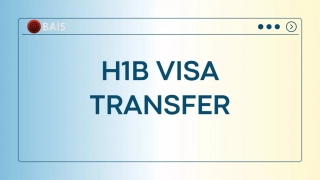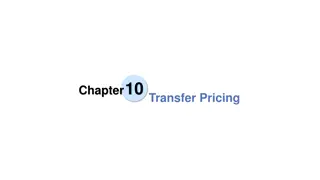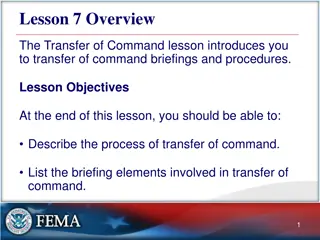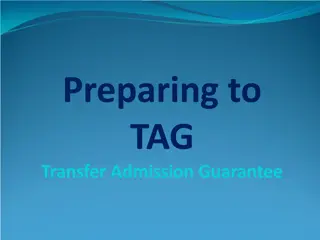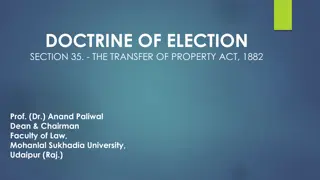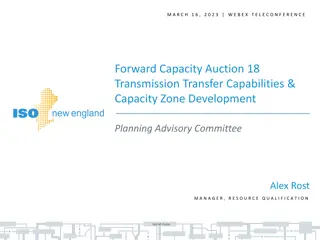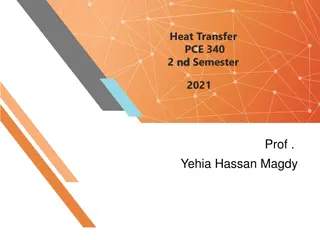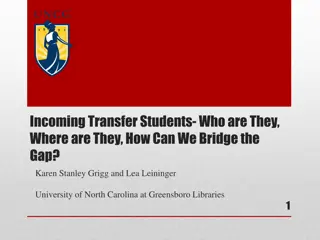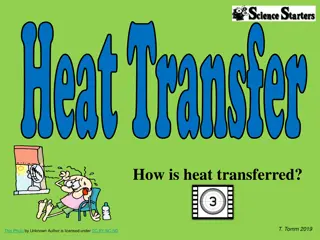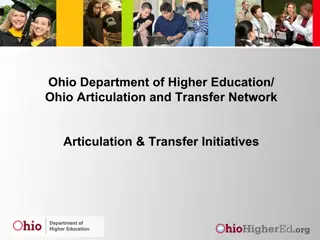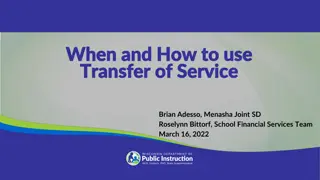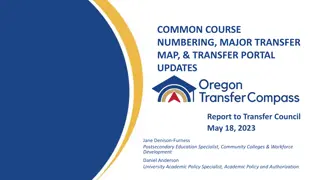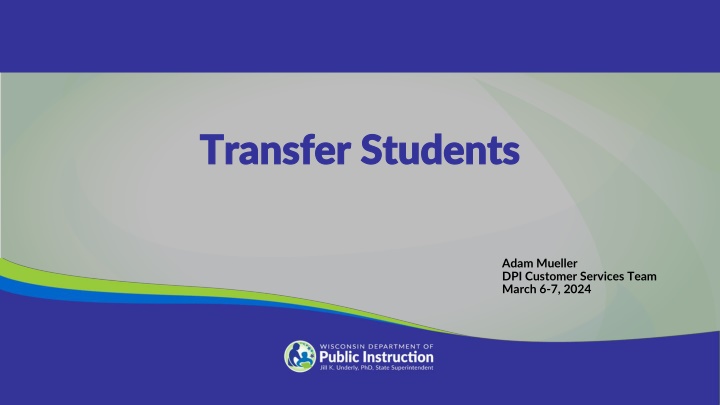
Student Transfers and Expected Scenarios in Education
Explore different scenarios related to student transfers in schools and districts, including expected transfers, dropouts, and more. Learn how to handle expected transfers efficiently to ensure smooth transitions for students.
Download Presentation

Please find below an Image/Link to download the presentation.
The content on the website is provided AS IS for your information and personal use only. It may not be sold, licensed, or shared on other websites without obtaining consent from the author. If you encounter any issues during the download, it is possible that the publisher has removed the file from their server.
You are allowed to download the files provided on this website for personal or commercial use, subject to the condition that they are used lawfully. All files are the property of their respective owners.
The content on the website is provided AS IS for your information and personal use only. It may not be sold, licensed, or shared on other websites without obtaining consent from the author.
E N D
Presentation Transcript
Transfer Students Transfer Students Adam Mueller DPI Customer Services Team March 6-7, 2024
Today's Goal We are going to talk about different scenarios for students leaving your school or district to better help you understand the process.
Todays Topics We will be discussing expected transfers and several other scenarios when a student is leaving your district. Expected transfers Dropouts No shows Homeschool Non-Choice private school enrollment Virtual students & RVAs Out-of-home placement (foster care) SPED Exiting students and Exit Types Summer transfers Overlapping Enrollments
Check-In Who here has dealt with expected transfers in the WISEdata Portal in the past? Who has received a dropout from not resolving an expected transfer?
Expected Transfers When you receive an expected transfer, it will show up in WISEdata under the Expected Transfers tab and on the Validation Messages tab as error 6578. KBA Error 6578 The KBA has a step-by-step walk-through of how to handle this situation.
Error 6578 (1 of 8) Error 6578 Short Text: Expected Transfer Response is missing. Long Text: Expected Transfer Response is missing. Another agency has submitted an expected transfer exit code (ETC) and listed your District/school as the location the student will enroll. You have not yet answered the expected transfer question for this student on the Expected Transfers screen. During the summer break, schools should wait to attempt to clear this message until the new school year has started, as you will not be able to verify the transfer until that time.
Error 6578 (2 of 8) How to Fix: Verify the student actually transferred or is planning to transfer to your district. Enter the requested expected transfer response with the appropriate answer. If you have proof of the transfer, enter Yes. If not, or the student will not enroll at your school, enter a response of No. To indicate your response, please log in to WISEdata Portal and follow these instructions:
Error 6578 (3 of 8) On the purple menu bar at the top, select Agency and then click Expected Transfers.
Error 6578 (4 of 8) Change the School Year if the default is not the one you need for this student.
Error 6578 (5 of 8) A list of students will auto-generate based on the school year selected. Locate the student and click the Link button.
Error 6578 (6 of 8) In the Expected Transfer Response Question section, select the appropriate response from the drop-down menu. Next, click Update.
Example Error 6578 (7 of 8) Error on student record that it s missing the expected transfer response. Student is transferring to Hawthorne Elementary in the Madison Metropolitan School District, from Edgewood Elementary in the Franklin School District. Since Edgewood listed Hawthorne as the transfer school, Hawthorne School now needs to respond as to whether or not the student enrolled at Hawthorne. Verifies student s enrollment date and attendance at Hawthorne. Enter a Yes value ( S - Yes, known to be continuing within this school ) from the dropdown menu on the Expected Transfer Response field question.
Error 6578 (8 of 8) Live demo in WISEdata
Frequency Frequency of checking the Expected Transfers Tab: When should you check and how often? Periodically, however, expected transfer validations will also show in the Validation Message list. Remember, not checking and resolving this can result in a dropout.
Transferring Out How to handle a student transferring out of your district when you know they are attending elsewhere? You will use exit type ETC and fill out where the student is going. ONLY put the new school after: You have confirmed with the parent and contacted and confirmed with the new school district that the student has transferred. ***The idea here is to avoid getting blindsided with a student transfer that may or may not be valid.
Dropouts (1 of 9) Not all dropouts are avoidable, but some are. Let's look at the types of dropouts and how to avoid the unnecessary ones.
Dropouts (2 of 9) What causes a dropout? Students grades 7-12 A student leaving school and not returning A student leaving school and not returning in the allotted time Not using the correct Exit Type Not responding to an Expected Transfer The new school not submitting an enrollment in WISEdata The new school creating a new WISEid instead of using the existing one
Dropouts (3 of 9) How to avoid unnecessary dropouts: Use the correct Exit Type. If you are unsure on the correct exit type, put in a help ticket. Respond to the Expect Transfers in the Expected Transfer tab in WISEdata. Communicate with the other district/school. Is the right WISEid being used? Are the correct dates being reported? This can also help ensure the student and their family have a good transition. Verify your data using the tools available to you.
Dropouts (4 of 9) Mid-Term Dropout vs Full-Term Dropout Mid-term: student leaves midway through the school year Full-term: student leaves after completing the full school year
Dropouts (5 of 9) Mid-Term Dropout example: A student left school on 12/1/23. They have until the following school year s Third Friday of September (TFS) to return. If they return after the TFS (9/20/24), they are considered a mid-term dropout.
Dropouts (6 of 9) Full-Term Dropout example: A student completed the school term and was present on the last day of school, 6/7/24. They have the entire next school year AND until the following school year s Third Friday of September (TFS) to return. If they return after the TFS (9/19/25), they are considered a full-term dropout.
Dropouts (7 of 9) Tools to help you avoid the unnecessary dropouts: Use WISEdata exports (Choice Schools) WISEdash for Districts (Public and Charter Schools)
Dropouts (8 of 9) Choice Schools: WISEdata Exports > WISEdash Extracts > Dropouts. If Yes in either Dropout Indicator column, student has potential to be a dropout.
Dropouts (9 of 9) Public Schools: WISEdash for Districts > Snapshots > YE Completion > Dropout
No Shows A student didn't show up, now what? Students who may have registered or intended to attend your school but did not show up for service should not be reported to WISEdata. Pull back your enrollment record from WISEdata using the Ed-Fi API ID. If you aren t sure how to pull enrollment records back, please work with your SIS. Neglecting to remove the record will most likely result in an overlapping enrollment or dropout.
No Shows: Open Enrollment Open enrollment no shows Once an open enrolled student has received any services from the district/school to which they opened enrolled, they are now that school s responsibility. That district/school will receive the dropout if the student leaves. If the student no shows at an open enrollment district and that district has never provided any services to the student, the responsibility then falls back to the student s resident district.
No-Show: In-District In-district no show If the student received any services during the school year, they will not be considered a no show and may be a dropout. If the student did not show and you have removed the student s record for the new school year, you may need to update the prior year s exit type. If the student shows up at another WISEdata reporting school, you can leave the exit type as TC. However, if the student no-showed and does not report at another agency, you will need to investigate and update the prior year exit type to ODO.
Homeschooling A student is leaving and will be doing homeschooling, what do you do? Verify the student is registered in the HOMER system. Once the student is registered in the HOMER system, you will exit the student on the last day they received services with an exit type of TNC. Students can attend up to two classes at your school and still be considered homeschooled and would not be reported in WISEdata.
Private Non-Choice School Your student is leaving for private school (non-Choice school). This means that the private school your student is leaving for does not report to WISEdata. In this scenario you will use exit type TNC.
Private Choice School Your student is leaving for a private school that participates in the Choice program and does report to WISEdata. Verify the school is a Choice school. Verify the student is a Choice participant. Some Choice schools report all students; some only report Choice participants. If student is a Choice participant and/or is reported in WISEdata, use TC exit. If student is not a Choice participant and not reported in WISEdata, use TNC exit.
Virtual Students Your student is leaving for a virtual school. If the school is in your district, they should be reported the same as a student in a building. It is still expected that the student is reported as normal, which includes the student's attendance. If the student is attending a virtual school not affiliated with your district, please work with the virtual school to ensure the student is reported appropriately between the two of you.
Rural Virtual Academy (RVA) Your student is leaving for a virtual school. If the school is in your district, work with the RVA to ensure the student will be reported correctly in WISEdata. It is still expected that the student is reported as normal, which includes the student s attendance. Students attending an RVA are most often still reported by the resident district. RVA will send the resident district the student s data for reporting in WISEdata. The only exception to this is the first year a district works with the RVA.
Rural Virtual Academy (RVA) (1 of 2) There are two different tiers of RVA partnering districts. 1. Affiliated: These are districts that are usually, but not always, in their first year of a 66.03.01 agreement with RVA, and it is seen as a trial run to ensure the partnership is beneficial to all included. During the affiliated year(s), RVA reports the students to WISEdata via the Medford School District and reports the resident district for FAPE and Accountability. This means the students are included in Medford s WISEdash Attending counts, but the Accountability/Pupil Count is attributed to the resident district. If the district does not have an RVA school code set up in School Directory, they are most likely an affiliate district, and Medford s RVA will report their students for that year.
Rural Virtual Academy (RVA) (2 of 2) There are two different tiers of RVA partnering districts. 2. Invested: Once an affiliated district commits to the RVA program, a new 66.03.01 agreement is created. This is seen as them officially entering the RVA consortium, and WISEdata reporting responsibilities revert to the resident district at this time. This is the usual case we see where the resident district is responsible for all student WISEdata reporting from the RVA. If the district has an RVA school set up for them in WISEdata, they are an invested district and are responsible for reporting to WISEdata.
Out-of-Home Placement Out-of-home placement (Foster Care) may result in change of district of residence and thus require a student transfer. In the rare scenario where a student is temporarily placed while awaiting subsequent court placement and is unable to receive educational services during the short placement in out-of-home care, then the district in which the out-of-home placement was made should not submit an enrollment to WISEdata.
Residential Care Centers Residential Care Centers Residential Care Centers (RCC) have special requirements for WISEdata enrollment. If a student has a current, active IEP and is placed in an RCC by a court, then the student will remain actively enrolled in WISEdata though district of residence may change. Other placements in an RCC should be treated as a gap in enrollment, and the student should be exited. Many students continue to receive educational services from their school during day treatment. If the student is unable to receive education services or has changed in residency, then the student should be exited, even if the gap is temporary.
SPED and Transfers It's important to pay extra close attention to SPED students who are transferring both in and out of your school/district. It is VERY IMPORTANT you pay attention to sSEPA record dates and align them with the student s enrollment dates. If the exit dates do not match, the student will not be captured correctly as a SPED student for Year-End reporting. sSEPA records also require a Special Education Exit Reason. This SPED exit reason should also align with the enrollment exit type.
Summer Transfers Summer school is not reported in WISEdata. Students transferring in the summer may need to be investigated to ensure the correct exit type is used in the prior year s enrollment record. If a student receives their diploma due to completion of summer school, their HSC exit and diploma are backdated to the prior year s enrollment record.
Overlapping Enrollments In the event you have an overlapping enrollment with another district, please reach out and work with them to resolve the overlap. In the event the other district is not responsive after three attempts, you can submit a help ticket explaining the situation for further assistance. When exiting a student, remember to exit them on the last day services were provided. When enrolling a student, the start date will be the day the services start. If the other district is reaching out prior to the transfer, it may be a good idea to make sure you have the dates lined up.
Helpful Resources Data Elements: List of links to all WISEdata data elements and their descriptions, uses, and codes Knowledge Base Articles: (KBA) Useful articles on validations and other related topics Uncommon Situations: Great place to look for outside of the norm situations Exit Types: A full listing of the different exit types for exiting students WISEtraining: A lot of helpful information. Additional trainings through E- learnings, Mini Tutorials and short videos
Staying in Contact Join the weekly WISE User Group Calls to hear weekly updates from different teams and ask questions of DPI staff on the call Google Currents/Workspaces is switching over to Teams! Stay tuned for communications from the Customer Services Team. Platform change will occur next week Submit a Help Ticket for our WISEsupport or Customer Service Team to assist you
Questions? Questions? Thank you! Thank you! Please scan the QR code to provide us with your feedback!

